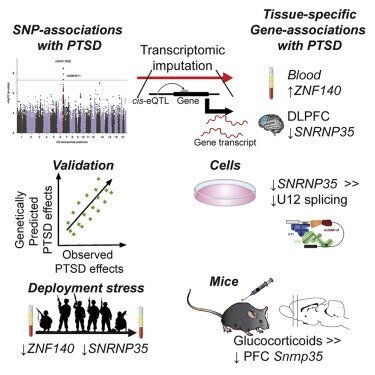Come here to read what we are reading and discuss science in the areas of sport, exercise, and stress physiology. Contact us to share your perspectives and inspiring science.

Analysis of genetically regulated gene expression identifies a prefrontal PTSD gene, SNRNP35, specific to military cohorts
Huckins et al. Cell Reports. 2020 June 2;31(9):107716.
Identifying genetic susceptibility and modifiability in PTSD
Identifying subjects who are more susceptible to PTSD (post-traumatic stress disorder) and how stress and training influence those factors to possibly affect resiliency over time and exposure, is a critical area of stress physiology research. This study tested 195,684 individuals including controls, from the largest cohort of PTSD genome-wide association studies (GWAS) data to discover possible factors that contribute to PTSD etiology in some individuals.
I am now following Dr. Laura M. Huckins on twitter. Check out her feed.
@LauraHuckins
CLICK on image for a great summary of spliceosomes in the journal, CELL.
Spliceosomes are important for cutting pre-mRNA to result in more mature mRNA that will go on to become translated into functional protein. Spliceosomes are important to how organisms regulate whether genes are turned on or off in times of need (e.g., stress)
SNRNP35 and spliceosomes are important for stress and disease
Dr. Huckins and others have identified that SNRNP35 is a part of the spliceosome, a huge complex in eukaryotic cells that is diverse, assembled, and responsible for cutting pre-mRNA to help the process of producing a mature mRNA that can be used by protein synthesis machinery to make functional protein. How spliceosome cuts and whether it does or not, can be different in individuals during disease, stress, and other contexts which we still do not fully understand. Observing that among 200,000 subjects, a SNRNP is revealed as something that may be related to PTSD occurrence or susceptibility is incredibly interesting. The psychological, traumatic disorder may have basis in fundamental cellular processes associated with regulating gene expression.

Molecular choreography of acute exercise
Contrepois, et al. Cell. 28 May 2020, 181(5): 1112-1130.e16
This recent publication, and the whole edition of Cell actually, is an excellent read for those of you interested in the same things we are. We work under this mathematical modeling approach to understanding complex stressors like exercise. Please keep updated with our page as we put out our data in this area. This is an exciting study.
The authors pursued an ambitious study, completing longitudinal multi-omic profiling of plasma and peripheral blood mononuclear cells including metabolome, lipidome, immunome, proteome, and transcriptome from 36 human subjects, before and after a controlled bout of symptom-limited exercise.
Researchers conducted a time-series analysis to reveal what authors call an “orchestrated choreography of biological processes involving energy metabolism, oxidative stress, inflammation, tissue repair, and growth factor response, as well as regulatory pathways.”
“Most of these processes were dampened and some were reversed in insulin-resistant participants. Finally, we discovered biological pathways involved in cardiopulmonary exercise response and developed prediction models revealing potential resting blood-based biomarkers of peak oxygen consumption.”
Here’s to the new world of biomarker monitoring in exercise and sport…



